Hunedoara, Romania is the location of an amazingly well-preserved Gothic castle that looks as if it dropped out of some fairytale. With a drawbridge, a moat, pointy towers, colonnades and gargoyles, all that the Hunedoara Castle lacks is a resident dragon. And it seems fitting that it is located in the evocative region of Romania known as Transylvania.
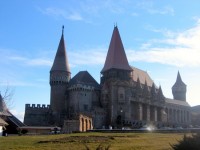 Most of what you can see today owes its existence to two periods of history, each connected with notable personages. An aristocratic family, known variously by the surnames Hunedoara, Hunyadi or Corvin, was given the castle in 1409 by Sigismund, King of Hungary, and kept it till 1506. During that century, the dynasty – which would produce Matthias Corvinus, a famous King of Hungary in his own right – had extensive construction work done on the castle. Other parts of the fortification date back to another time, nearly two hundred years later, when the Transylvanian ruler, Gábor Bethlen, directed that the castle be the location for meetings of the Transylvanian parliament, or “Diet.”
Most of what you can see today owes its existence to two periods of history, each connected with notable personages. An aristocratic family, known variously by the surnames Hunedoara, Hunyadi or Corvin, was given the castle in 1409 by Sigismund, King of Hungary, and kept it till 1506. During that century, the dynasty – which would produce Matthias Corvinus, a famous King of Hungary in his own right – had extensive construction work done on the castle. Other parts of the fortification date back to another time, nearly two hundred years later, when the Transylvanian ruler, Gábor Bethlen, directed that the castle be the location for meetings of the Transylvanian parliament, or “Diet.”
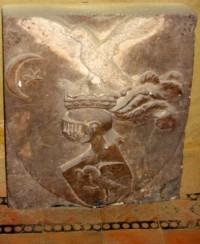 Legend claims that King Sigismund gave the castle to the Hunyadi family because they were of his own blood. Legend further asserts that Sigismund once gave a ring to a woman with whom he had an affair, pledging that he would take care of her if she had a baby by him. She did bear his child, so she set off, with ring in hand, to remind the ruler of what he had promised. The ring was snatched by a crow on her way to see him, but it came into the king’s possession anyway when he shot the bird. He remembered the woman and, thus, gave her the castle. A crow with its beak clutching a ring became the family emblem, and can be spotted in some of the castle’s carved doorframes and columns.
Legend claims that King Sigismund gave the castle to the Hunyadi family because they were of his own blood. Legend further asserts that Sigismund once gave a ring to a woman with whom he had an affair, pledging that he would take care of her if she had a baby by him. She did bear his child, so she set off, with ring in hand, to remind the ruler of what he had promised. The ring was snatched by a crow on her way to see him, but it came into the king’s possession anyway when he shot the bird. He remembered the woman and, thus, gave her the castle. A crow with its beak clutching a ring became the family emblem, and can be spotted in some of the castle’s carved doorframes and columns.
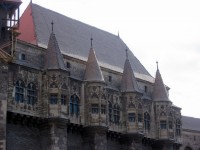 You enter the castle by walking over the drawbridge on its northern side which takes you through a tower with a gate. As you pass through the gate to the main courtyard, you will see, on your right, the west wing which was created during the 1440s and 1450s. Its ground floor features a large hall where knights would banquet. Today it contains medieval armor and weaponry exhibits. The upper floor holds a hall that would have been used for formal ceremonies, and it was here that the Diet held its assemblies. All of the painted murals in the hall date from that period.
You enter the castle by walking over the drawbridge on its northern side which takes you through a tower with a gate. As you pass through the gate to the main courtyard, you will see, on your right, the west wing which was created during the 1440s and 1450s. Its ground floor features a large hall where knights would banquet. Today it contains medieval armor and weaponry exhibits. The upper floor holds a hall that would have been used for formal ceremonies, and it was here that the Diet held its assemblies. All of the painted murals in the hall date from that period.
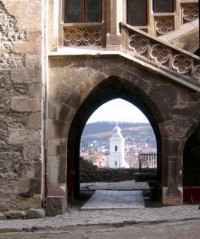 The tower adjacent to these halls was built during the Hunyadis’ time as was the castle on the northern side of the courtyard. There are two rows of arches on top of each other, and as you walk through these you can see wall-paintings that depict the legend of how the castle came to be the property of the family. Nearby is the room of the princesses, which today houses models and diagrams of the castle.
The tower adjacent to these halls was built during the Hunyadis’ time as was the castle on the northern side of the courtyard. There are two rows of arches on top of each other, and as you walk through these you can see wall-paintings that depict the legend of how the castle came to be the property of the family. Nearby is the room of the princesses, which today houses models and diagrams of the castle.
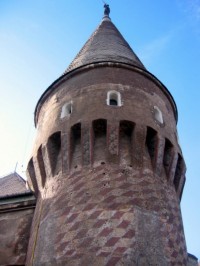 Walk out the gate to the east of the courtyard – past the 100-foot well dug by Turkish prisoners – and you step onto an artillery terrace that dates from Bethlen’s time. This terrace culminates in the “mace tower,” whose outer surface bears remnants of a chequered paint design. The terrace affords the opportunity to admire the masonry and gargoyles of the castle’s outer walls. The east wing of the castle also was added in the time of Bethlen. It includes an imposing colonnade of arches.
Walk out the gate to the east of the courtyard – past the 100-foot well dug by Turkish prisoners – and you step onto an artillery terrace that dates from Bethlen’s time. This terrace culminates in the “mace tower,” whose outer surface bears remnants of a chequered paint design. The terrace affords the opportunity to admire the masonry and gargoyles of the castle’s outer walls. The east wing of the castle also was added in the time of Bethlen. It includes an imposing colonnade of arches.
At the southern end of the courtyard is a bluff tower which used to be the castle’s main entrance, and was constructed under the Hunyadi’s direction. You’ll also 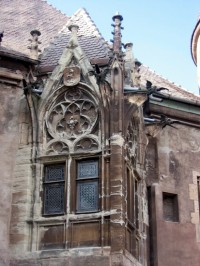 notice a weird, long part extending from the castle’s south end, a place to retreat if the castle’s vulnerable south flank was attacked. It ends with a tower which was christened “Ne Boisa” (a Slavic phrase meaning “don’t fear”) by the Serb mercenaries who used to man the castle.
notice a weird, long part extending from the castle’s south end, a place to retreat if the castle’s vulnerable south flank was attacked. It ends with a tower which was christened “Ne Boisa” (a Slavic phrase meaning “don’t fear”) by the Serb mercenaries who used to man the castle.
One thing that makes a visit to this castle particularly haunting is the proliferation of empty shells of buildings that litter the landscape around the castle. The remants of these structures used to belong to an enormous, communist-era steel factory.
Hunedoara is about eight miles from the town of Deva, 60 miles from the major city of Sibiu, and 80 miles from Timisoara. If you are using public transportation, take a train to Deva and then take a bus that departs from a stop in front of the train station. Even better, since the bus goes to downtown Hunedoara rather than the castle itself, just jump in a taxi.
